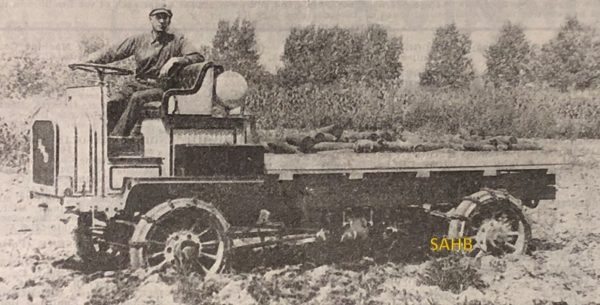
The Four Wheel Drive Auto Company (FWD), developed and produced all-wheel drive vehicles. Otto Zachow and William Besserdich founded the company in 1909, in Clintonville, Wisconsin, as the Badger Four-Wheel Drive Auto Company. Besserdich and Zachow’s patented full-time four-wheel drive system combined a lockable centre differential with double-Y constant velocity universal joints for steering.
The trucks were highly successful in early military tests. Our Snapshot comes from an advertisement in the March 1916 issue of Dun’s Review, and proudly explains the results of the trials. The caption to the image is very formal, clearly taken from the test report: “241-24683. X. O. 8/13/15. Four Wheel Drive Auto Truck. Full load in fresh plowed ground. Dry on top, wet underneath. Cutting about ten inches. Speed about four miles per hour.” There were three further official pictures with War Department reports of effectiveness in increasingly challenging conditions. Finally, there was a quote from “One of the leading European Governments”:
“The F.W.D. trucks have never failed in any task assigned them. The repairs have really been negligible. The ammunition is being taken to the guns on the immediate front on F.W.D. trucks because they are the only trucks that can make the journey.”
In 1916 the U.S. Army ordered 147 Model B three-ton trucks for the Pancho Villa Expedition, and during World War I ordered 15,000 of the same model, with over 14,000 actually delivered; more orders came from the UK and Russia.
Early FWD vehicles were made with a track width of 4 feet 8½ inches so they could quickly be used on a standard gauge railway line simply by changing the wheels. Four other manufacturers produced the Model B under licence during World War I: Peerless, Kissel, Premier and Mitchell. A Canadian subsidiary was set up in conjunction with Dominion Truck of Kitchener, Ontario by 1919, and in 1921 a British subsidiary was set up in Slough. In 1926 the British FWD, also known as the Quad, was produced with a larger 70 bhp engine.
In 1931 the company worked with Harry Miller, resulting in the construction of the Four Wheel Drive Miller that competed successfully at the Indianapolis 500 in 1931 and later. The intention was to prove that FWD’s lockable centre differential was equally effective outside off-road applications.
The UK history of FWD can be traced further. In 1932, AEC took a controlling interest in the British company and began to use more standard AEC components in the Slough-built vehicles, and marketed them under the Hardy name. Production ended in about 1936, but AEC used its experience with all-wheel drive in its Second World War Matador (4×4) and Marshall (6×6) vehicles.
The story of the FWD cannot end without mention of Luella Bates, believed to be the first licensed woman truck driver in the USA. She was the first of six female employees of the Four Wheel Drive Auto Co., chosen as test and demonstration drivers. She worked as an FWD truck driver from 1918 to 1922, and during World War I she was a test driver traveling throughout the state of Wisconsin in a Model B truck. After the war, she remained as the sole female demonstrator and driver. FWD sent her on three transcontinental tours throughout the United States during 1920. The advertising used Bates, as a woman, to show that the FWD truck was easy to steer. In May 1920, Popular Science magazine referred to her as “exhibit A for feminine efficiency.”
Picture courtesy of the Richard Roberts Archive







Leave a Comment